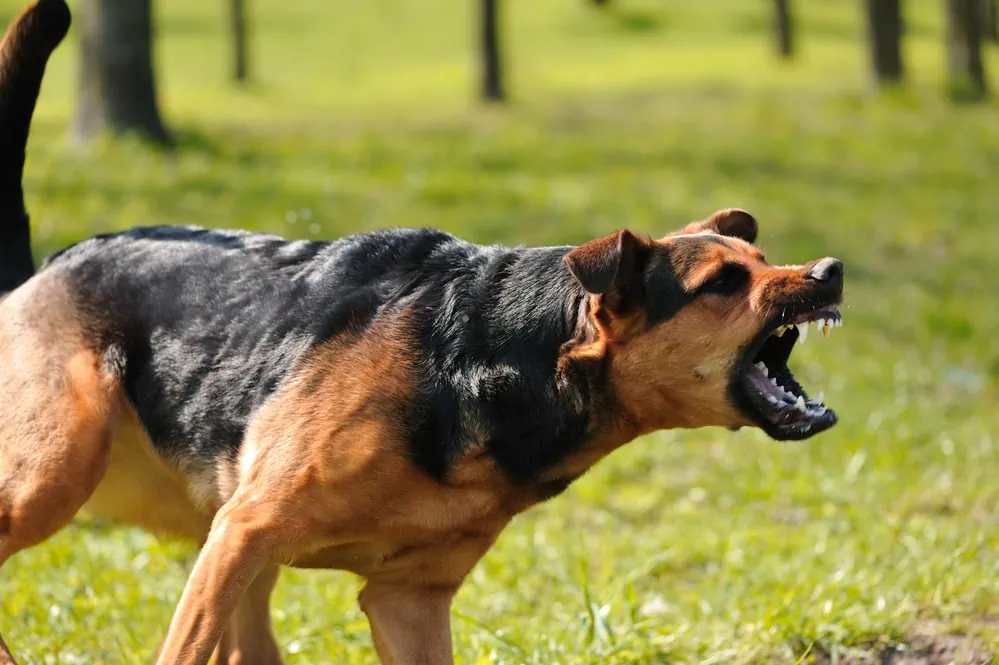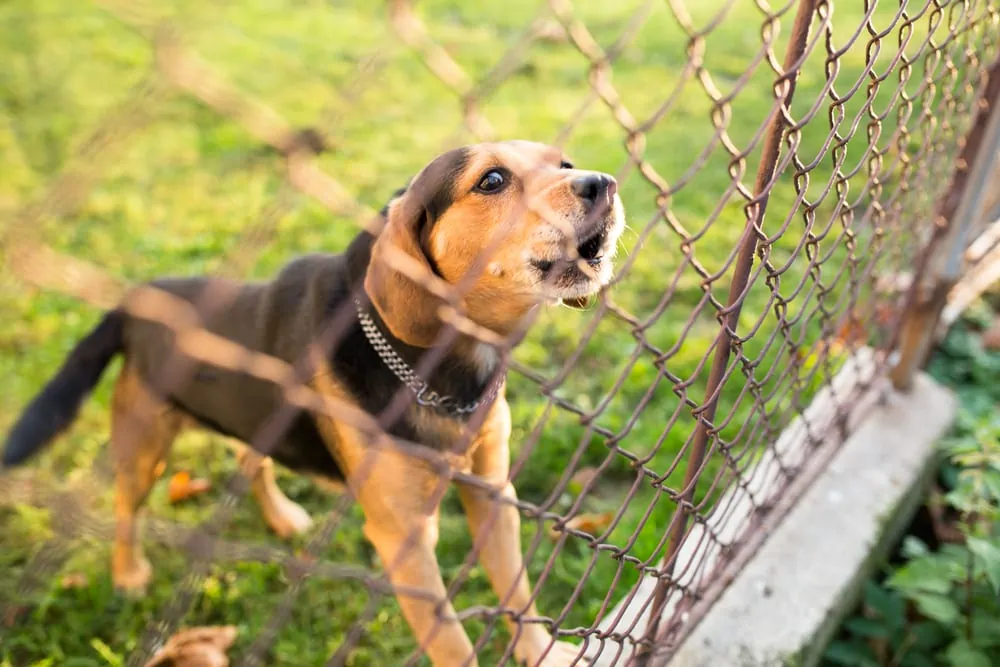Dogs bark, it is in their nature.
Quite a few years ago now, my dog and I took a puppy-training class.
The most memorable moment was something the trainer said, “Dogs bark, birds sing.”
You can’t change the nature of the beast.
Barking is how a dog communicates.
“Dogs bark because it works, whether to scare off a perceived intruder, self-soothe, get attention or release frustration” (source).
Why does my dog bark back when scolded?
When you scold your dog, chances are your voice is loud and your body is tense. If your voice is loud, your dog may think you are barking, so they are just joining in. This may also cause him to be stressed or anxious, and a dog’s normal reaction to this is to bark.
To help you better understand why your dog is barking, this article will cover why barking is essential to the human/canine relationship, how to understand bark tone, as well as provide tips and tools for when your dog continually barks such as training, helpful devices found in pet stores or on-line, and even, if necessary, surgery.
How do dogs communicate?

Dogs communicate with us through barking and body language, and we communicate with them through tone and body language.
According to Webster’s Dictionary, communication is: “a process by which information is exchanged between individuals through a common system of symbols, signs or behavior.”
During the process of interactings with dogs, humans began to learn to speak “dog,” and dogs gained the ability to “understand” human emotion (source).
Not all barks sound the same.
As babies have an array of different cries, so dogs have different barks.
There are many reasons your dog may be barking.
They may be demanding your attention or an object, playing, trying to raise an alarm, or alert you to a potential threat.
They may be frustrated, bored, excited, anxious, or afraid.
Before training your dog to stop barking, it is imperative to first know what he is trying to tell you.
Decoding the Bark
You may be thinking, “I just want the barking to stop!” I get it; I live with five dogs, so barking can get intense.
Before you train your dog to not bark, keep in mind there are times that you want him to.
Learning the different barks prior to training your dog will go a long way in producing a long and happy relationship.
Demand Barking
They are looking for attention.
They may be bored, frustrated, excited you’re home or want food or an out-of-reach toy.
Demand barking is often a few short barks in a row, and your dog will be relaxed while looking at you for what he wants (source).
Perhaps something is irritating them, like their collar for dogs that have sensitive necks.
Alert Barking
Your dog wants you to be aware of a potential threat or danger.
Your dog will bark three or four times in succession with pauses and will have a mid-range pitch.
When the barking is rapid, still mid-range, they are giving an alarm of imminent danger.
When the bark gets deeper and is continuous, they are preparing to defend (source).
They are basically telling the UPS man to run!
Anxious
Your dog’s bark will be short, at a high pitch, and he may also howl, oftentimes, sounding mournful.
He misses you when you are not home and wants you to turn around and come home (source).
Playing
To initiate play, your dog may use a stutter bark at mid-range.
As play continues, the bark will go higher and their body will be very relaxed and wriggly (source).
Fearful
When afraid, your dog will bark in combination with growls.
The barking is at a lower pitch and their body is stiff.
The accompanying growl can be a warning to stay back, can mean “I feel threatened, help,” or can mean “I’m scared but will defend.”
Oftentimes, this can be mistaken for aggression as the dog may jump toward what they fear rather than back away.
You will have to try to understand what your dog is feeling (source).
Dogs use howls, growls, whines, whimpers, barks, body language, and intonation to convey to their human what they need.
For instance, certain growls can be a playful or serious warning.
Whines can be as simple as your dog wanting something he can’t reach.
Whimpers could indicate pleasure; however, if your dog yelps, he may be extremely afraid or in intense pain.
Here’s a short tip on how to teach any dog to stop barking:
What should I do when my dog barks back at me? The Do’s and Don’ts of training

The Do’s
Use a positive approach.
There are many training methods out there.
You can find do-it-yourself videos, books, articles, or use a professional trainer.
Using rewards such as treats when your dog sits on command is very effective.
It does not have to be food. It can be as simple as praise and attention from you.
Dogs value the attention of their humans above all else.
If you are attempting to train your dog not to bark at everything that moves in his line of sight, you can block his view.
If he barks at every sound he hears, white noise or background noise will help.
You can find a variety of options on the internet from meditation music to stations for dogs.
Using a product with synthetic pheromones can prove de-stressing.
The mixture imitates the smell of a mother dog and can be calming in many situations.
You can find the pheromones in sprays or plug-in warmers.
You could ignore the barking by turning away or leaving the room.
Once he stops barking, offer a treat.
This should teach him that not barking is rewarding.
The hush of quiet command allows you to control how much he barks.
The object is that he will stop barking when you say, “Hush.”
Hold a treat and while your dog is barking show it to him.
This should interrupt the barking.
Say, “Hush,” and give him the treat. To be effective, do not let your dog bark more than once or twice.
Exercise, while not a training tool, is essential to a well-behaved dog.
It may not stop the barking, but your dog will be tired and less prone to react to everything going on around him.
A tired dog is a content dog, and a home with a content dog is a happy home.
Now I know the do’s, what are the don’ts?
Don’t yell, scream, hit, or otherwise harshly punish your dog.
Punishment alone will not change the behavior.
For example, your dog may almost knock you down when you walk in the door.
You want them to sit and wait to say hello.
If you yell and push him away your dog achieves their goal of your attention which reinforces the jumping.
Better to ignore your dog and only give your attention when they sit and wait for you.
The use of anti-barking collars is highly debated.
There are three types: spray, shock, and ultrasonic.
Spray collars puff citronella into the dog’s face when they bark.
The collar may not react to certain pitches, rendering them ineffective.
A shock collar uses electrical impulses sent through prongs that sit against the dog’s throat and is the most inhumane.
An ultrasonic collar emits a high-pitched sound which only your dog can hear, like dog whistles (source).
While some trainers use such punishments, others argue that you never want to use negative reinforcement to train your dog.
These collars are used as punishment and have the potential to seriously harm your dog.
Punishment combined with pain will result in your dog being stressed, and possibly afraid of you.
Your job is to protect them, not hurt them.
Venticulocordectomy
Venticulocordectomy, commonly known as debarking, is one solution to a dog who constantly barks.
This may sound cruel.
However, there is a healthy debate about the pros and cons of this procedure.
Debarking is the process of removing tissue from the dog’s vocal cords, resulting in a quieter or husky bark.
As with any surgical procedure, there are risks both during and after surgery.
There can be a swelling, infection, and gagging.
Also, scar tissue can form, leading to more surgery and, of course, the potential for death while under anesthesia.
The discomfort after surgery is like that of a human tonsillectomy.
There is also the risk that their bark could come back and may need more surgery (source).
Why would anyone do this to their dog?
According to the American Veterinary Medical Association, “canine devocalization should only be performed by qualified, licensed veterinarians as a final alternative after behavioral modification efforts to correct excessive vocalization have failed” (source).
Other organizations, including the ASPCA and the Humane Society, agree with the AVMA recommendation.
There are times when a dog is considered a nuisance and there is a danger of the animal losing its home or, worse, of being euthanized.
This surgery saves lives.
**Did you happen to hit your dog out of anger? Find out what you need to do from there in this guide here!!!**
How do I assert myself as the leader of the pack? Why is it important?

Although you are human and naturally believe you will be in control, you could not be more wrong.
There is nothing funnier than a dog running circles around their small human, literally.
This does not have to be you.
By the way, the size of the human does not matter.
Even a small child could be an alpha.
Follow the leader
I cannot overstate that if you want a well-behaved dog who listens to your every command, you need to be the pack leader or alpha to your dog.
Every pack, whether wolf or dog, has a leader.
Even domesticated dogs need someone to look up to.
The alpha, usually male, commands respect and absolute obedience from the pack.
Becoming that leader, or alpha, in your relationship is paramount to you having control rather than the other way around.
If your dog doesn’t respect you, he’ll never listen to you, negating all your efforts to train him.
Steps to becoming the alpha
Show authority and confidence.
Use a firm, not loud, voice.
Never bend down to your dogs’ level as they will see that you are being submissive to him.
Maintain eye contact when giving commands.
If your dog tries to defy you, continue to stare into their eyes until they look away.
Hold onto your dog’s muzzle gently when giving directions and even while petting him.
This shows you have control but are not upset with them (source).
Ignore the behavior you are trying to break
Telling them to stop jumping will only increase their jumping because they’re getting your attention.
Completely ignore the behavior, and acknowledge them once they have stopped on their own.
Have a set routine
Dogs, babies, and children all need a set routine.
With a routine comes a sense of security and being protected.
This is the job of the alpha, and your dog will appreciate you.
Set clear boundaries right away
Enforce the rules you decide upon and do not have a just-this-once attitude.
Once is all it takes to undo what he has learned.
Never allow your dog to growl at you in anger
You should be able to touch your dog anywhere, including pulling their tail and ears, sticking your fingers in their mouth, playing with their paws without the dog growling, barking, and biting.
Always be first
The alpha is always ahead of the pack.
Be the first one through a door or down a hall.
Never step over your dog, but gently use your foot to nudge them until they move out of your way.
Nothing in the pack is free; everything has a price
Your dog should know commands like “Down,” “Sit,” and “Stay.”
They can then earn or work for their food, toys, treats, and even walks.
No leash pulling
Your dog should walk next to or slightly behind you, think loose leash.
The alpha always walks alone.
Exercise isn’t just walking!
It can be a job – play fetch where your dog continues to bring the ball or stick back to you and keep it when playtime is over.
Don’t play rough. If you lose, you are no longer the leader.
What is not alpha behavior?

Being an alpha is hard work, so you certainly don’t want to do anything to compromise your position.
Do not:
Alter the schedule or routine if you can help it
As I stated above, your dog needs to feel safe.
Never use corporal punishment
You should under no circumstances hit your dog. He is looking to you for protection.
Alpha is always cool, calm, and collected.
Do not put your pup in time out away from the family
It is not only cruel but could result in more undesirable behavior.
Do not yell at your dog just because you had a bad day.
Recommended Read: Getting your puppy to stop biting, here’s what you need to do.
Final Thoughts
If your dog barks at you after you scolded them, your dog is most likely feeling stressed.
When dogs feel stressed, they react by barking.
Of course, your dog could grumble at you under his breath.
My thought on that?
He totally understands what I said.
Being a pet parent is not easy, but it is very worth every ounce of effort.


0 Comments